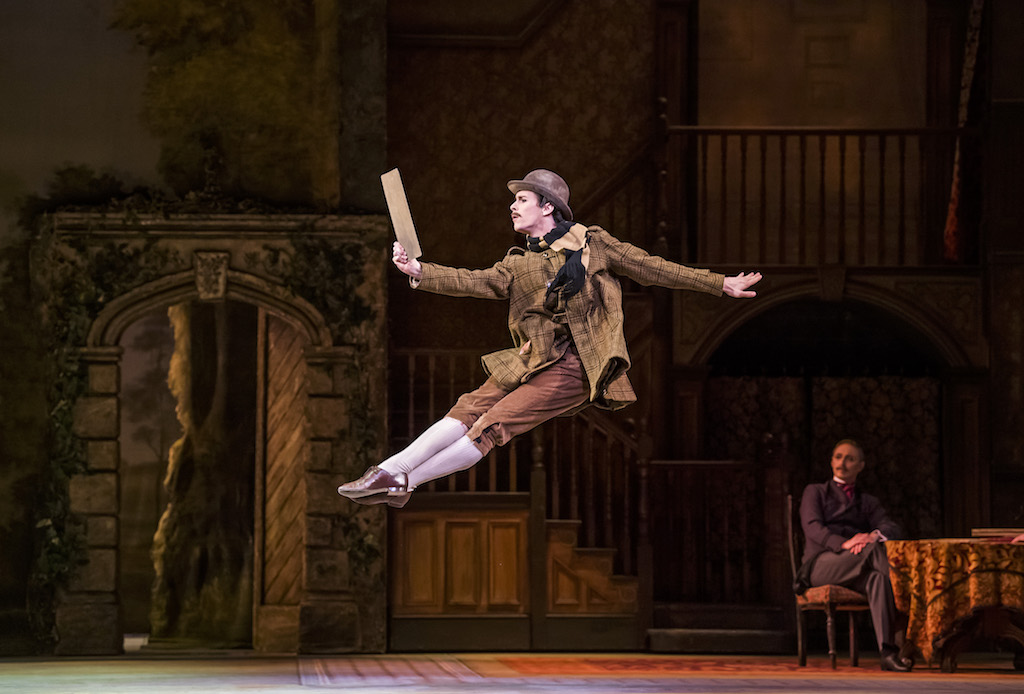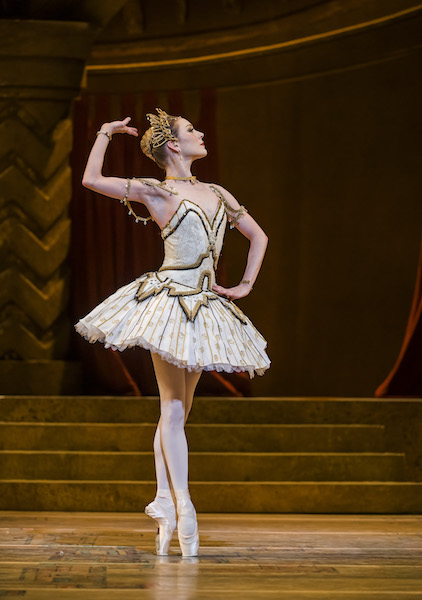Concerto/Enigma Variations/Raymonda Act III, Royal Ballet review - time to cheer the corps de ballet | reviews, news & interviews
Concerto/Enigma Variations/Raymonda Act III, Royal Ballet review - time to cheer the corps de ballet
Concerto/Enigma Variations/Raymonda Act III, Royal Ballet review - time to cheer the corps de ballet
Three revivals from the mid-Sixties allow the rank and file to shine
As a mood-lifter, it’s hard to beat the opening of Concerto. Against a primrose sky, figures in daffodil, tangerine and brick form lozenges of fizzing colour, foregrounded by a leading couple so buoyant their heels barely ever touch down.
In its outer movements Concerto gives the whole company a good airing, and the corps its share of challenging steps at speed. It’s almost a relief, prompting laughter, when in the final movement, as pianist Kate Shipway commands the keyboard like a battleground, the massed dancers cease their constant leaping to march on pointe. All that vivid energy makes the central movement, a pas de deux, the more serene. Lauren Cuthbertson is magnificently pliant and focused here, employing the stoic Reece Clark's forearm as a ballet barre. Anna Rose O’Sullivan deserves mention too for her grace at speed in the outer movements, chaperoned by Marcelino Sambé, a dancer who could out-bounce Tigger. Enigma Variations, Frederick Ashton’s portraits of the friends and relations that inspired Edward Elgar’s composite work, has aged less well – which is curious, given that the piece was deliberately old-fashioned when he made it. Perhaps it’s the lowering effect of all that brown: brown furniture, brown panelling, tweed jackets and tobacco pipes. Perhaps – perish the thought – its glorifying of provincial Englishness has picked up the taint of Brexit. As ever, though, when this company revives this piece of beloved Ashtonia (pictured above), the performances are impeccable. Laura Morera is subtly heartbreaking as Elgar’s wife, despite the fact that all she is given to do is sympathise. Francesca Hayward is fresh and lovely as young Dora Penney, cutting through the too-easy winsomeness. And as AJ Jaeger, Elgar's closest friend, Bennet Gartside – in the sudden hush of the “Nimrod” variation – adjusts his spectacles and looks at his feet, unmanned by, well, what? His reluctance to advise his as-yet-unpublished composer friend to give up the struggle? So elliptical is this work that we never quite know, and that enigma is part of its charm.
Enigma Variations, Frederick Ashton’s portraits of the friends and relations that inspired Edward Elgar’s composite work, has aged less well – which is curious, given that the piece was deliberately old-fashioned when he made it. Perhaps it’s the lowering effect of all that brown: brown furniture, brown panelling, tweed jackets and tobacco pipes. Perhaps – perish the thought – its glorifying of provincial Englishness has picked up the taint of Brexit. As ever, though, when this company revives this piece of beloved Ashtonia (pictured above), the performances are impeccable. Laura Morera is subtly heartbreaking as Elgar’s wife, despite the fact that all she is given to do is sympathise. Francesca Hayward is fresh and lovely as young Dora Penney, cutting through the too-easy winsomeness. And as AJ Jaeger, Elgar's closest friend, Bennet Gartside – in the sudden hush of the “Nimrod” variation – adjusts his spectacles and looks at his feet, unmanned by, well, what? His reluctance to advise his as-yet-unpublished composer friend to give up the struggle? So elliptical is this work that we never quite know, and that enigma is part of its charm.
 Rudolf Nureyev’s version of the final act of Raymonda – one of the late, great, Imperial ballets rarely seen complete – caps the evening with a dose of all-out grandeur. Under the gilded byzantine domes of Barry Kay’s set the corps again come to the fore, this time as kid-booted, egret-feather-hatted Hungarians celebrating a aristocratic wedding. The folk-dance imbued choreography, all clicked heels and hands on waists, is recognisably Marius Petipa's from 1898. The medieval scenario is pure hokey, but thankfully there is no plot to bother us by the time the ballet reaches Act III. Sarah Lamb (pictured right) glitters nicely in the title role, although her little handclaps in the famous solo are oddly underpowered. Couldn't someone persuade Sylvie Guillem, memorable in this role, to do a spot of coaching in imperiousness? Perhaps not. It was left to Vadim Muntagirov as returning Crusader Jean de Brienne to show us how high classicism is done. Expansive and plush as an oligarch's bank account, his jumps are magnificent, and when he attends to his ballerina, it's royal treatment, nothing less.
Rudolf Nureyev’s version of the final act of Raymonda – one of the late, great, Imperial ballets rarely seen complete – caps the evening with a dose of all-out grandeur. Under the gilded byzantine domes of Barry Kay’s set the corps again come to the fore, this time as kid-booted, egret-feather-hatted Hungarians celebrating a aristocratic wedding. The folk-dance imbued choreography, all clicked heels and hands on waists, is recognisably Marius Petipa's from 1898. The medieval scenario is pure hokey, but thankfully there is no plot to bother us by the time the ballet reaches Act III. Sarah Lamb (pictured right) glitters nicely in the title role, although her little handclaps in the famous solo are oddly underpowered. Couldn't someone persuade Sylvie Guillem, memorable in this role, to do a spot of coaching in imperiousness? Perhaps not. It was left to Vadim Muntagirov as returning Crusader Jean de Brienne to show us how high classicism is done. Expansive and plush as an oligarch's bank account, his jumps are magnificent, and when he attends to his ballerina, it's royal treatment, nothing less.
rating
Explore topics
Share this article
The future of Arts Journalism
You can stop theartsdesk.com closing!
We urgently need financing to survive. Our fundraising drive has thus far raised £49,000 but we need to reach £100,000 or we will be forced to close. Please contribute here: https://gofund.me/c3f6033d
And if you can forward this information to anyone who might assist, we’d be grateful.

Subscribe to theartsdesk.com
Thank you for continuing to read our work on theartsdesk.com. For unlimited access to every article in its entirety, including our archive of more than 15,000 pieces, we're asking for £5 per month or £40 per year. We feel it's a very good deal, and hope you do too.
To take a subscription now simply click here.
And if you're looking for that extra gift for a friend or family member, why not treat them to a theartsdesk.com gift subscription?
more Dance
 'We are bowled over!' Thank you for your messages of love and support
Much-appreciated words of commendation from readers and the cultural community
'We are bowled over!' Thank you for your messages of love and support
Much-appreciated words of commendation from readers and the cultural community
 R:Evolution, English National Ballet, Sadler's Wells review - a vibrant survey of ballet in four acts
ENB set the bar high with this mixed bill, but they meet its challenges thrillingly
R:Evolution, English National Ballet, Sadler's Wells review - a vibrant survey of ballet in four acts
ENB set the bar high with this mixed bill, but they meet its challenges thrillingly
 Like Water for Chocolate, Royal Ballet review - splendid dancing and sets, but there's too much plot
Christopher Wheeldon's version looks great but is too muddling to connect with fully
Like Water for Chocolate, Royal Ballet review - splendid dancing and sets, but there's too much plot
Christopher Wheeldon's version looks great but is too muddling to connect with fully
 iD-Reloaded, Cirque Éloize, Marlowe Theatre, Canterbury review - attitude, energy and invention
A riotous blend of urban dance music, hip hop and contemporary circus
iD-Reloaded, Cirque Éloize, Marlowe Theatre, Canterbury review - attitude, energy and invention
A riotous blend of urban dance music, hip hop and contemporary circus
 How to be a Dancer in 72,000 Easy Lessons, Teaċ Daṁsa review - a riveting account of a life in dance
Michael Keegan-Dolan's unique hybrid of physical theatre and comic monologue
How to be a Dancer in 72,000 Easy Lessons, Teaċ Daṁsa review - a riveting account of a life in dance
Michael Keegan-Dolan's unique hybrid of physical theatre and comic monologue
 A Single Man, Linbury Theatre review - an anatomy of melancholy, with breaks in the clouds
Ed Watson and Jonathan Goddard are extraordinary in Jonathan Watkins' dance theatre adaptation of Isherwood's novel
A Single Man, Linbury Theatre review - an anatomy of melancholy, with breaks in the clouds
Ed Watson and Jonathan Goddard are extraordinary in Jonathan Watkins' dance theatre adaptation of Isherwood's novel
 Peaky Blinders: The Redemption of Thomas Shelby, Rambert, Sadler's Wells review - exciting dancing, if you can see it
Six TV series reduced to 100 minutes' dance time doesn't quite compute
Peaky Blinders: The Redemption of Thomas Shelby, Rambert, Sadler's Wells review - exciting dancing, if you can see it
Six TV series reduced to 100 minutes' dance time doesn't quite compute
 Giselle, National Ballet of Japan review - return of a classic, refreshed and impeccably danced
First visit by Miyako Yoshida's company leaves you wanting more
Giselle, National Ballet of Japan review - return of a classic, refreshed and impeccably danced
First visit by Miyako Yoshida's company leaves you wanting more
 Quadrophenia, Sadler's Wells review - missed opportunity to give new stage life to a Who classic
The brilliant cast need a tighter score and a stronger narrative
Quadrophenia, Sadler's Wells review - missed opportunity to give new stage life to a Who classic
The brilliant cast need a tighter score and a stronger narrative
 The Midnight Bell, Sadler's Wells review - a first reprise for one of Matthew Bourne's most compelling shows to date
The after-hours lives of the sad and lonely are drawn with compassion, originality and skill
The Midnight Bell, Sadler's Wells review - a first reprise for one of Matthew Bourne's most compelling shows to date
The after-hours lives of the sad and lonely are drawn with compassion, originality and skill
 Ballet to Broadway: Wheeldon Works, Royal Ballet review - the impressive range and reach of Christopher Wheeldon's craft
The title says it: as dancemaker, as creative magnet, the man clearly works his socks off
Ballet to Broadway: Wheeldon Works, Royal Ballet review - the impressive range and reach of Christopher Wheeldon's craft
The title says it: as dancemaker, as creative magnet, the man clearly works his socks off
 The Forsythe Programme, English National Ballet review - brains, beauty and bravura
Once again the veteran choreographer and maverick William Forsythe raises ENB's game
The Forsythe Programme, English National Ballet review - brains, beauty and bravura
Once again the veteran choreographer and maverick William Forsythe raises ENB's game

Add comment